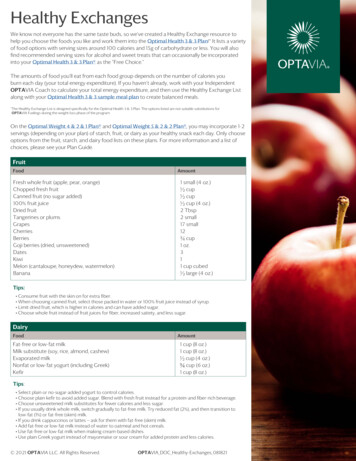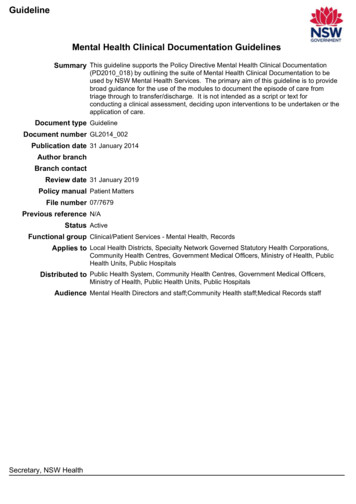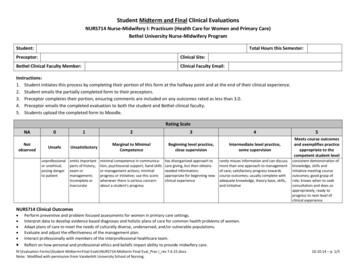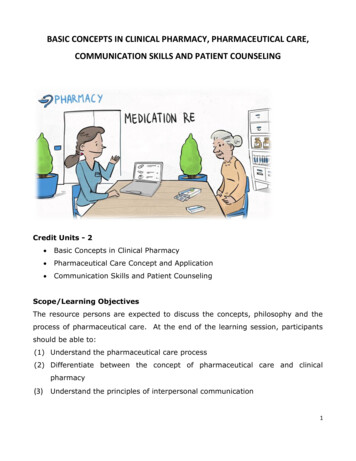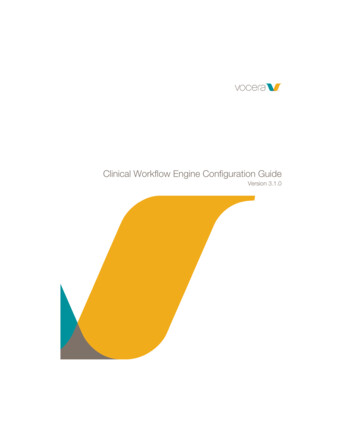
Transcription
Clinical Studies Overview
Table of ContentsThe Science Behind Medifast :A Foundation for Better Health 4A Distinguished ScientificAdvisory Board 5The 5 & 1 Plan 6Arterburn (2019) Shikany (2013) Coleman (2012) Davis (2010) The 4 & 2 & 1 Plan 7891011Beavers (2018) Normandin (2018) Coleman (2015) 121314The 5 & 2 & 2 Plan 15Dimachkie (2021) Hamilton–Reeves (2020) Kiel (2015) 161718Diabetes 19Coleman (2017) Cheskin (2008) Polycystic Ovarian Syndrome (PCOS) Yuh (2011) 220212223
Seniors 24Miller (2021) Quillen (2020) Serra (2019) Weaver (2019) Beavers (2018) Shaver (2018) Normandin (2018) Kelleher (2017) Beavers (2015) 252627282930313233Teenagers 34Cheskin (2007) 35Trp64Arg Gene Variant 36Obesity Pharmacotherapy 38Non–PharmaceuticalAppetite Suppressants 41Tchernof (2000) Moldovan (2016) Haddock (2008) Matalon (2000) Medifast Products Miller (2021) Davis (2008) 37394042434445References 463
The Science Behind Medifast: A Foundation forBetter HealthObesity is considered one of the most pressing health issues of our time. 1 Over 70% of adults inthe United States (US) are overweight, including more than 42% classified as having obesity. 2, 3Being overweight or obese increases the risk of developing many related, often seriousconditions (e.g. heart disease, stroke, diabetes and even some forms of cancer) and has asubstantial economic impact. 1, 4, 5 Though estimates vary, a recent analysis found the aggregatemedical cost of obesity for US adults exceeded 260 billion. 6 Furthermore, the average annualmedical costs for those with obesity are 2,500 higher than people in a normal weight range. 6–8Other countries are also experiencing growing rates of obesity. 9 Worldwide, obesity has nearlytripled since 1975. 9 Weight loss can help to reduce both the medical and economic impact ofobesity by decreasing the risk of developing associated conditions. 10–18 Unfortunately, while thereare many options available for managing weight, not all are healthy, safe or effective.The long–standing scientific heritage of Medifast, the company behind OPTAVIA, combinedwith the support of an independent OPTAVIA Coach and like–minded OPTAVIA Community,clinically proven plans, and scientifically designed products is what makes us a comprehensiveapproach to Lifelong Transformation, One Healthy Habit at a Time . All of our programsfeature a combination of OPTAVIA Fuelings (meal replacements), conventional food choices,easy–to–understand meal plans and customizable levels of support for weight loss and weightmaintenance—all backed by our team of registered dietitian nutritionists, behavioral experts andfood scientists.Our inclusive approach to weight management aligns well with the guidelines for themanagement of overweight and obesity issued by the American Heart Association, the AmericanCollege of Cardiology and The Obesity Society. These guidelines recommend individuals whoare currently at an unhealthy weight (overweight or obese) participate in a comprehensivelifestyle program which includes a reduced calorie diet, exercise and support that promotespositive behavioral changes, as the cornerstone of all treatment options, with the goal ofachieving clinically meaningful weight loss of at least 5–10% within a 6–month period. 4 Theseguidelines also support the use of commercial weight loss programs as an option for weight loss,provided they are backed by evidence of their safety and efficacy and offer a comprehensivelifestyle intervention. 4Research also supports the use of meal replacements as a safe and effective tool for limitingcalorie intake and promoting weight loss and maintenance among individuals who are overweightor obese.19–26 Similarly, the OPTAVIA Fuelings serve as a convenient, individually–portioned,calorie–controlled source of nutrition. These tasty offerings are at the heart of Medifast’sclinically proven plans, helping individuals manage their weight quickly, safely and simply.We invite you to read this Medifast Clinical Studies Overview, a compilation of abstracts frompeer–reviewed clinical research of randomized, controlled trials, prospective and retrospectivestudies that support the use of our products and programs in a wide variety of populations.All studies were conducted in the US. Not all of the programs studied are available in allinternational markets.4
A Distinguished Scientific Advisory BoardThe Medifast Scientific Advisory Board is comprised of internationally–recognized experts, all ofwhom have made significant contributions in their respective field. The function of the ScientificAdvisory Board is to provide objective insight and external expertise to help guide Medifastin making informed, evidence–based decisions on medical, nutritional and scientific matters.The Scientific Advisory Board serves as a part of our foundation to create scientifically–valid,consumer–centric, high–quality innovations for lasting health.This cross–disciplinary group consists of distinguished physicians, academic researchers,nutrition and health–related policy experts. The work of this prestigious board builds onMedifast’s scientific and clinical heritage, which focuses on sound approaches to weightmanagement while exploring forward–looking innovations, product and program offerings andclinical research opportunities.Medifast first formed their Scientific Advisory Board in 2008. As of January 2022 the MedifastScientific Advisory Board is comprised of the following experts:George Bray, MDCarsten Smidt, PhD, FACNSteven Heymsfield, MDSylvia B. Rowe, MAMark Messina, PhDMark Matlock, MSBoyd Professor Emeritus,Pennington BiomedicalResearch Center, LouisianaState UniversityPresident, SR Strategyand Adjunct Professor atTufts Friedman Schoolof Nutrition Science andPolicy and University ofMassachusetts, AmherstOwner, Smidt Labs, Inc. andFellow, American Collegeof NutritionCo–owner, Nutrition Matters,Inc., Director, NutritionScience and Research, SoyNutrition Institute Global, andAdjunct Associate Professor,Loma Linda UniversityProfessor and Director,Metabolism & BodyComposition Laboratory,Pennington BiomedicalResearch Center, LouisianaState University(Retired) Senior VicePresident, Archer DanielMidland (ADM); Fellow,American Oil Chemists Society5
The 5 & 1 Plan
Arterburn (2019)Randomized Controlled Trial Assessing Two Commercial Weight LossPrograms in Adults with Overweight or ObesityLM Arterburn 1, CD Coleman 1, J Kiel 1, K Kelley 2, L Mantilla 2, N Frye 1, K Sanoshy 2, CM Cook 21Department of Scientific and Clinical Affairs, Medifast, Inc., Baltimore, Maryland, USABiofortis, Mérieux NutriSciences, Addison, IL, tyle interventions remain thecornerstone for obesity treatment.Commercial programs offer oneweight loss approach, yet theefficacy of few such programshave been rigorously investigated.The purpose of this study wasto evaluate the efficacy of twocommercial weight–loss programs,both utilizing pre–portionedmeal replacements (MRs) anddifferent levels of behavioralsupport, compared to a self–directed control diet in adults withoverweight and obesity.In this 16–week study, participantswere randomized to the low–calorie OPTAVIA 5 & 1 Planwith telephone coaching (OPT),the reduced–calorie Medifast4 & 2 & 1 self–guided plan (MED),or a self–directed, reduced–caloriecontrol diet. Differences in weight,body composition (DXA) and bodycircumferences, all measuredmonthly, were assessed byanalysis of covariance with sex andbaseline measures as covariates.Of 198 participants randomized(80.8% female, BMI 34.2 kg/m2,45.7 years), 92.3% completedthe study.The OPT and MED groups hadsignificantly greater reductionsin body weight (–5.7% and –5.0%,respectively, p 0.0001), fat andabdominal fat mass (p 0.0001)and waist and hip circumferences(p 0.003) than control at 16 weeks.Weight change was correlatedwith MR usage and completion ofcoaching support calls.CONCLUSIONS:Both structured commercial programs were more efficacious than a self–directed, reduced–calorie dietfor weight loss and other anthropometric measures. Evidence–based commercial programs can be animportant tool to help adults with overweight and obesity lose clinically relevant amounts of weight.REFERENCE:Arterburn L.M., Coleman C.D., Kiel J., Kelley K., Mantilla L., Frye N., Sanoshy K., Cook C.M. (2019). Randomized Controlled Trial Assessing TwoCommercial Weight Loss Programs in Adults with Overweight or Obesity. Obes Sci Pract, 5(1):3–14. doi: doi.org/10.1002/osp4.312.The 5 & 1 Plan7
Shikany (2013)Randomized Controlled Trial of the Medifast 5 & 1 Plan for Weight lossJM Shikany 1,2, AS Thomas 1, TM Beasley 3, CE Lewis 1,2, DB Allison 2,4Division of Preventive Medicine, School of Medicine, University of Alabama at Birmingham, Birmingham, AL, USA; 2Nutrition ObesityResearch Center, University of Alabama at Birmingham, Birmingham, AL, USA; 3Department of Biostatistics, School of Public Health,University of Alabama at Birmingham, Birmingham, AL, USA; 4Dean’s Office, School of Public Health, University of Alabama at Birmingham,Birmingham, AL, USA.1PURPOSE/OBJECTIVE:METHODS/DESIGN:RESULTS:The Medifast 5 & 1 Plan (MD) is aportion–controlled, nutritionally–balanced, low–fat weight–lossplan. We studied the effects ofMD compared with a reduced–energy, food–based diet (FB) onbody weight, waist circumference,fat mass and other measuresin adults.We conducted a two–parallel–arm, randomized, controlledtrial comparing MD to FB over52 weeks. A total of 120 menand women aged 19–65 yearswith BMI 35 and 50 kg/m 2 wererandomized to MD (n 60) or FB(n 60). Follow–up included a26–week weight–loss phase and26–week weight–maintenancephase. Anthropometric, bodycomposition, biochemical andappetite/satiety measures wereperformed at baseline and at 26and 52 weeks. An intention–to–treat, linear mixed models analysiswas the primary analysis.Fifty MD subjects (83.3%) and 45FB subjects (75.0%) completedthe study on assigned treatment.At 26 weeks, race–adjustedmean weight loss was 7.5 kgin MD subjects vs 3.8 kg in FBsubjects (p 0.0002 for difference);reduction in waist circumferencewas 5.7 cm in MD vs 3.7 cm inFB (p 0.0064); and fat massloss was 6.4 kg in MD vs 3.7 kgin FB (p 0.0011). At 52 weeks,the corresponding reductionswere 4.7 vs 1.9 kg (p 0.0004); 5.0vs 3.6 cm (p 0.0082); and 4.1 vs1.9 kg (p 0.0019) in MD and FBsubjects, respectively.CONCLUSIONS:In obese adults, MD resulted in significantly greater reductions in body weight and fat compared with aFB diet for 1 year after randomization.REFERENCE:Shikany J.M., Thomas A.S., Beasley T.M., Lewis C.E., Allison D.B. (2013). Randomized Controlled Trial of the Medifast 5 & 1 Plan for Weight Loss.Int J Obes (Lond), 37(12), 1571–1578. doi: doi.org/10.1038/ijo.2013.43.8The 5 & 1 Plan
Coleman (2012)Use of the Medifast Meal Replacement Program for Weight Loss in Overweightand Obese Clients: A Retrospective Chart Review of Three Medifast WeightControl Centers (MWCC)C Coleman 1, J Kiel 1, A Hanlon–Mitola 2, C Sonzone 1, N Fuller 1, LM Davis 11Medifast, Inc., Owings Mills, Maryland, USA; 2Private Practice, Clifton Park, New York, USA.PURPOSE/OBJECTIVE:METHODS/DESIGN:RESULTS:A chart review was performed toevaluate the effectiveness of theMedifast (MD) meal replacement(MR) plan in three Medifast WeightControl Centers (MWCC) on bodyweight, body composition, andother health measures at 4, 12, 24weeks, and final weight loss visit.Charts included adults aged 18–70(n 446) with a BMI 25 kg/m 2 whoattended one of three MWCCsand were following the MD MRprogram. Data were collectedelectronically and included weight,systolic and diastolic bloodpressure, pulse, lean muscle mass(LMM), body fat mass, % body fat,and abdominal circumference.Compliance measures includedattendance at weekly visits, intakeof MRs and supplements, foodjournals, and ketone testing.Significant weight loss and %weight loss were achieved atall time points with clinicallysignificant weight loss ( 5%)occurring in just 4 weeks.Additionally, significantimprovements in bodycomposition were seen at all timepoints coupled with increasesin % total body weight as LMM(% LMM improved by 3.5, 9.8,16.0, and 13.9%, respectively).Blood pressure and pulsewere significantly improved,demonstrating the clinicalbenefit for clients. Multivariateregression revealed a stronginverse relationship betweenweight change, % compliancewith attendance, and the numberof weeks that MRs were takenas recommended as well as apositive association with numberof ketone tests.CONCLUSIONS:The MD MR plan, combined with the support and accountability available in the MWCC, is anefficacious program that promotes significant weight loss and improvements in body composition.These results reveal significant associations between components of compliance and weight loss, butparticularly highlight the importance of attendance, a focus of the MWCC model compared tonon–clinic models.REFERENCE:Coleman C., Kiel J., Hanlon–Mitola A., Sonzone C., Fuller N., Davis L.M. (2012). Use of the Medifast Meal Replacement Program for Weight Loss inOverweight and Obese Clients: A Retrospective Chart Review of Three Medifast Weight Control Centers (MWCC). Food and Nutrition Sciences,03(10), 1433–1444. doi: http://dx.doi.org/10.4236/fns.2012.310187.The 5 & 1 Plan9
Davis (2010)Efficacy of a Meal Replacement Diet Plan Compared to a Food–based DietPlan After a Period of Weight Loss and Weight Maintenance: A RandomizedControlled TrialLM Davis 1, C Coleman 1, J Kiel 1, J Rampolla 1, T Hutchisen 1, L Ford 1, WS Andersen 1, A Hanlon–Mitola 21Research & Development, Medifast, Inc., Owings Mills, Maryland, USA; 2Private Practice, Clifton Park, New York, ty has reached epidemicproportions in the United States.It is implicated in the developmentof a variety of chronic diseasestates and is associated withincreased levels of inflammationand oxidative stress.This 40–week randomized,controlled clinical trial included90 obese adults with a bodymass index (BMI) between 30and 50 kg/m 2, randomly assignedto one of two weight lossprograms for 16 weeks and thenfollowed for a 24–week periodof weight maintenance. Thedietary interventions consistedof Medifast’s meal replacementprogram for weight loss andweight maintenance, or a self–selected isocaloric, food–basedmeal plan.Weight loss at 16 weeks wassignificantly better in the Medifastgroup (MD) versus the food–basedgroup (FB) (12.3% vs. 6.7%), andwhile significantly more weightwas regained during weightmaintenance on MD versusFB, overall greater weight losswas achieved on MD versus FB.Significantly more of the MDparticipants lost 5% of theirinitial weight at week 16 (93%vs. 55%) and week 40 (62% vs.30%). There was no differencein satiety observed between thetwo groups during the weight lossphase. Significant improvementsin body composition were alsoobserved in MD participantscompared to FB at week 16 andweek 40. At week 40, both groupsexperienced improvements inbiochemical outcomes and otherclinical indicators.The objective of this study is toexamine the effect of Medifast’smeal replacement program(MD) on body weight, bodycomposition, and biomarkers ofinflammation and oxidative stressamong obese individuals followinga period of weight loss and weightmaintenance compared to anisocaloric, food–based diet (FB).CONCLUSIONS:Our data suggest that the meal replacement diet plan evaluated was an effective strategy for producingrobust initial weight loss and for achieving improvements in a number of health–related parametersduring weight maintenance, including inflammation and oxidative stress, two key factors more recentlyshown to underlie our most common chronic diseases.REFERENCE:Davis L.M., Coleman C., Kiel J., Rampolla J., Hutchisen T., Ford L., Andersen W., Hanlon–Mitola A. (2010). Efficacy of a Meal Replacement DietPlan Compared to a Food–based Diet Plan After a Period of Weight Loss and Weight Maintenance: A Randomized Controlled Trial. Nutr J, 9, 11.doi: 10.1186/1475–2891–9–11.10The 5 & 1 Plan
The 4 & 2 & 1 Plan
Beavers (2018)Effect of an Energy–Restricted, Nutritionally Complete, Higher Protein MealPlan on Body Composition and Mobility in Older Adults with Obesity: ARandomized Controlled TrialKM Beavers 1, BA Nesbit 1, JR Kiel 2, JL Sheedy 1, LM Arterburn 2, AE Collins 1, SA Ford 1, RM Henderson 3,CD Coleman 2, DP Beavers 4Department of Health and Exercise Science, Wake Forest University, Winston–Salem, North Carolina; 2Department of Scientific and ClinicalAffairs, Medifast, Inc., Baltimore, Maryland; 3Department of Internal Medicine, Section on Gerontology and Geriatric Medicine, Winston–Salem, North Carolina; 4Department of Biostatistical Sciences, Wake Forest School of Medicine, Winston–Salem, North :Increasing protein content ofthe diet might be an effectivestrategy to preserve muscle massin older adults undergoing caloricrestriction, thereby preservingmuscle function.Ninety–six older adults (70 3.7years, 74% women, 27% AfricanAmerican) with obesity (35.4 3.3kg/m2; 47% total body fat) wererandomized to a 6–month higherprotein (providing 1.2–1.5 g/kg/d)weight loss (WL) program, utilizingthe Medifast 4 & 2 & 1 Plan, or toweight stability (WS). Dual–energyx–ray absorptiometry–acquiredtotal body mass and composition,and fast gait speed over 400–mwas assessed at baseline, 3, and6 months.At baseline, dual–energy x–rayabsorptiometry–acquired totalbody, fat, and lean masses were95.9 14.6, 44.6 7.6, and 48.7 9.5 kg, respectively, and 400–mgait speed was 1.17 0.20 m/s.Total body mass was significantlyreduced in the WL group (–8.17[–9.56, –6.77] kg) compared tothe WS group (–1.16 [–2.59, 0.27]kg), with 87% of total mass lostas fat (WL: –7.1 [–8.1, –6.1] kg;–15.9% change from baseline).A differential treatment effectwas not observed for change inlean mass (WL: –0.81 [–1.40, –0.23]kg vs WS: –0.24 [–0.85, 0.36] kg).Four–hundred–meter gait speedwas also unchanged from baselinealthough trends suggest slightlyincreased gait speed in the WLgroup [0.01 (–0.02, 0.04) m/s]compared with the WS group[–0.02 (–0.05, 0.01) m/s].CONCLUSIONS:Intentional weight loss using a high–protein diet is effective in producing significant total body massand fat mass loss, while helping preserve lean body mass and mobility, in relatively high–functioningolder adults with obesity.REFERENCE:Beavers K.M., Nesbit B.A., Kiel J.R., Sheedy J.L., Arterburn L.M., Collins A.E., Ford S.A., Henderson R.M., Coleman C.D., Beavers D.P. (2018) Effectof an Energy–Restricted, Nutritionally Complete, Higher Protein Meal Plan on Body Composition and Mobility in Older Adults with Obesity: ARandomized Controlled Trial. J Gerontol A Biol Sci Med Sci. 74(6):929–935. doi: 10.1093/gerona/gly146.12The 4 & 2 & 1 Plan
Normandin (2018)Feasibility of Weighted Vest use During a Dietary Weight Loss Interventionand Effects on Body Composition and Physical Function in Older AdultsE Normandin 1, D Yow 1, C Crotts 1, J Kiel 2, KM Beavers 3, BJ Nicklas 1,3Section on Gerontology and Geriatric Medicine, Wake Forest School of Medicine, Winston–Salem, NC 27157, USA; 2Department of Scientificand Clinical Affairs, Medifast, Inc., Baltimore, MD 21202, USA; 3Department of Health and Exercise Science, Wake Forest University,Winston–Salem, NC 27109, ground: While intentionalweight loss in older adults withobesity yields clinically importanthealth benefits there is a need tominimize the negative effects ofweight loss on concomitant lossof muscle mass and strength. Datashow wearing weighted vests duringexercise improves lean mass andlower extremity strength, howeverthe efficacy of wearing a weightedvest during a period of weight lossto mitigate muscle and strength lossis not known.Design: Randomized, controlledpilot study.Average weighted vest use was 6.7 2.2 hours/day and the vest–weargoal of 10 hrs/day was achieved for67 22% of total intervention days.Five participants reported adverseevents from wearing the vest (allback pain or soreness). Both groupslost a similar amount of weight(Diet –11.2 4.4 kg; Diet Vest –11.0 6.3 kg; p 0.001), with no differencesbetween groups (p 0.25). Fatmass, lean mass, and % body fatdecreased significantly (p 0.0001),with no differences between groups.Compared to Diet Vest, the Dietintervention resulted in greaterdecreases in leg power (p 0.02), withno other between group differencesin physical function.Objectives: This study examinedthe feasibility of daily weightedvest use during a dietary weightloss intervention, and examinedeffects of vest use on bodycomposition and physical functionin well–functioning older adultswith obesity.Setting: Wake Forest Baptist MedicalCenter in Winston–Salem, NC.Participants: 37 older (age 65–79years), obese (BMI 30–40 kg/m2)sedentary men and women.Interventions: 22–week behavioraldiet intervention (targeting 10%weight loss, 1100–1300 kcals/day)with (Diet Vest; n 20) or without(Diet; n 17) weighted vest use (goalof 10 hours/day with weight addedweekly according to individual lossof body mass).Measurements: Bodycomposition by dual–energy x–rayabsorptiometry and measures ofphysical function, mobility, andmuscle strength/power.CONCLUSIONS:This pilot study showed that vest use during dietary weight loss is feasible and safe in well–functioningolder adults with obesity. Larger studies are needed to definitively determine whether externalreplacement of lost weight during caloric restriction may preserve lower extremity muscle strengthand power.REFERENCE:Normandin E., Yow D., Crotts C., Kiel J., Beavers K.M., Nicklas B.J.(2018) Feasibility of Weighted Vest Use During a Dietary Weight LossIntervention and Effects on Body Composition and Physical Function in Older Adults. J of Frailty & Aging; 2018;7(3):198–203.doi: 10.14283/jfa.2018.17.The 4 & 2 & 1 Plan13
Coleman (2015)Effectiveness of a Medifast Meal Replacement Plan on Weight, BodyComposition, and Cardiometabolic Risk Factors in Overweight and ObeseAdults: A Multicenter Systematic Retrospective Chart ReviewCD Coleman 1, JR Kiel 1, AH Mitola 2, JS Langford 1, KN Davis 1, LM Arterburn 11Department of Scientific and Clinical Affairs, Medifast, Inc., 11445 Cronhill Drive, Owings Mills, MD, United States andIndependent Consultant, Clifton Park, NY, United ecent medical guidelinesemphasize the importance ofactively treating overweight andobesity with diet and lifestyleintervention to achieve 5%weight loss in a 6–month period.Commercial programs offerone approach provided there isevidence of their efficacy andsafety. This study was conductedto evaluate the effectiveness ofthe Medifast 4 & 2 & 1 Plan onweight loss, body compositionand cardiometabolic risk factors inoverweight and obese adults.A systematic retrospectivechart review of 310 overweightand obese clients following theMedifast 4 & 2 & 1 Plan at one of 21Medifast Weight Control Centerswas conducted. Data wererecorded electronically and keydata points were independentlyverified. The primary endpointwas change from baseline bodyweight at 12 weeks. Within grouppaired t–tests were used toexamine changes from baselinein a completers population.Differences between gender andage subgroups were examinedusing bivariate t–tests and mixedmodel regression analyses.For the primary endpoint at12 weeks, body weight amongcompleters (n 185) was reducedby a mean of 10.9 5.6 kg (10.1%,p 0.0001), and at 24 weeks (n 81)mean weight was reduced by 16.0 7.9 kg (14.3%). At 12 and 24 weeks,85% and 96% of those remainingon the plan, respectively, had lost 5% of their baseline body weight.Lean mass was preserved to within5% of baseline throughout the 24weeks, and fat mass represented 80% of the body weight lost from12 weeks onward. Men, women,seniors ( 65 yrs), and non–seniors( 65 yrs) all had significant weightreductions with preservationof lean mass. Significantimprovements in blood pressure,pulse and waist–to–hip ratio wereobserved. Mean weight regainamong the subset who entereda formal maintenance phase was 2% during an average follow–up of34 weeks. The meal plan was welltolerated, and program adherencewas 85%.CONCLUSIONS:The 4 & 2 & 1 Plan used at Medifast Weight Control Centers was effective for weight loss, preservationof lean mass and improvement in cardiometabolic risk factors. The plan was generally well tolerated ina broad population of overweight and obese adults. #NCT02150837.REFERENCE:Coleman C.D., Kiel J.R., Mitola A.H., Langford J.S., Davis K.N., Arterburn L.M., (2015) Effectiveness of a Medifast Meal Replacement Program onWeight, Body Composition and Cardiometabolic Risk Factors in Overweight and Obese Adults: A Multicenter Systematic Retrospective ChartReview Study. Nutr J, 14, 77. doi: 10.1186/s12937–015–0062–8.14The 4 & 2 & 1 Plan
The 5 & 2 & 2 Plan
Dimachkie (2021)Exploration of Biomarkers from a Pilot Weight Management Study for MenUndergoing Radical ProstatectomyMD Dimachkie 1, MD Bechtel 1, HL Robertson 1, C Michel 1, EK Lee 1, DK Sullivan 2, P Chalise 3, JB Thrasher 1, WPParker1, AK Godwin 4, HB Pathak 4, J DiGiovanni 5, N Shivappa 6,7,8, JR Hébert 6,7,8, JM Hamilton–Reeves 1,2Department of Urology, University of Kansas Medical Center, Kansas City, KS; 2Department of Dietetics & Nutrition, University of Kansas MedicalCenter, Kansas City, KS; 3Department of Biostatistics, University of Kansas Medical Center, Kansas City, KS; 4Department of Pathology & LaboratoryMedicine, University of Kansas Medical Center, Kansas City, KS; 5Division of Pharmacology and Toxicology, College of Pharmacy, The University ofTexas at Austin, Austin, TX; 6Cancer Prevention and Control Program, University of South Carolina, Columbia, SC 29208;7Department of Epidemiology and Biostatistics, Arnold School of Public Health, University of South Carolina, Columbia, SC; 8Connecting HealthInnovations LLC, Columbia, l biologic mechanisms,including inflammation andimmune changes, have beenproposed to explain the role ofobesity in prostate cancer (CaP)progression. Compared to menof a healthy weight, overweightand obese men are more likelyto have CaP recurrence post–prostatectomy. Obesity is relatedto inflammation and immunedysregulation; thus, weight lossmay be an avenue to reduceinflammation and reverse theseimmune processes.Twenty overweight menundergoing prostatectomyparticipated in this study. Fifteenmen chose the intervention and5 men chose the noninterventiongroup. The interventionconsisted of a comprehensiveweight loss program prior toprostatectomy and a weightmaintenance program followingsurgery. Prostate tissue sampleswere obtained from diagnosticbiopsies before the interventionand prostatectomy samplesafter weight loss. Blood samplesand diet records were collectedat baseline, pre–surgery afterweight loss and at study endafter weight maintenance.Immunohistochemistry andNanoString analysis were used toanalyze the tissue samples. Flowcytometry was used to assesscirculating immune markers.Inflammation markers weremeasured using Luminex panels.The intervention group lost 5% bodyweight prior to surgery. DII scoresimproved during the weight lossintervention from baseline to pre–surgery (p 0.002); and between groupdifferences were significant (p 0.02).DII scores were not associated withIL–6 nor hsCRP. In the intervention,CXCL12, CXCR7, and CXCR4 (C–X–Cmotif chemokine ligand/receptor)and Ki67 expression decreased in theprostate tissue from biopsy to surgery(p 0.06), yet plasma CXCL12 increasedduring the same timeframe (p 0.009).The downregulation of several genes(FDR 0.001) was observed in theintervention compared to the non–intervention. Changes in immune cellswere not significant in either group.This study explores thereversibility of the biologicalmechanisms through intentionalweight loss using a comprehensiveweight management program inmen undergoing prostatectomy.Outcomes include blood andtissue biomarkers, microtumorenvironment gene expression,inflammation markers and DietaryInflammatory Index (DII) scores.CONCLUSIONS:This feasibility study demonstrates that in overweight men with localized CaP, weight loss alters blood,and tissue biomarkers, as well as tumor gene expression. More research is needed to determine thebiological and clinical significance of these findings.REFERENCE:Dimachkie M. D., Bechtel M. D., Robertson H. L., Michel C., Lee E. K., Sullivan D. K., Chalise P., Thrasher J. B., Parker W. P., Godwin A. K.,Pathak H. B., DiGiovanni J., Shivappa N., Hébert J. R., Hamilton–Reeves J. M. (2021). Exploration of Biomarkers from a Pilot Weight ManagementStudy for Men Undergoing Radical Prostatectomy. Urologic Oncology: Seminars and Original Investigations. doi:10.1016/j.urolonc.2021.01.010.16The 5 & 2 & 2 Plan
Hamilton–Reeves (2020)Feasibility of a Weight Management Program Tailored for Overweight Menwith Localized Prostate Cancer – A Pilot StudyJM Hamilton–Reeves 1,2, CN Johnson 1, LK Hand 2, MD Bechtel 1, HL Robertson 1, C Michel 1, M Metcalf 1,P Chalise 3, NJ Mahan 2, M Mirza 1, EK Lee 1, DK Sullivan 2, JR Klemp 4, CA Beforte 5, WP Parker1, HD Gibbs 2,W Demark–Wahnefried 6, JB Thrasher 1Department of Urology, University of Kansas Medical Center, Kansas City, Kansas, USA; 2Department of Dietetics & Nutrition, University ofKansas Medical Center, Kansas City, Kansas, USA; 3Department of Biostatistics, University of Kansas Medical Center, Kansas City, Kansas,USA; 4Breast Cancer Prevention Center, University of Kansas Medical Center, Westwood, Kansas, USA; 5Department of PreventativeMedicine and Public Health, University of Kansas Medical Center, Kansas City, Kansas, USA; 6Department of Nutrition Sciences, Universityof Alabama at Birmingham, Birmingham, Alabama, eight men with prostatecancer a
The Medifast 5 & 1 Plan (MD) is a portion-controlled, nutritionally-balanced, low-fat weight-loss plan. We studied the effects of MD compared with a reduced-energy, food-based diet (FB) on body weight, waist circumferenc




